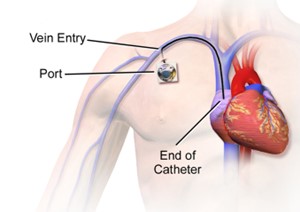The nurse is caring for a patient who has septic shock. Which assessment finding is most important for the nurse to report to the health care provider?
Oxygen saturation 92%
Skin cool and clammy
Blood pressure (BP) 92/56 mm Hg
Heart rate 118 beats/minute
The Correct Answer is B
A. Oxygen saturation of 92% in (option A) is incorrect because While an oxygen saturation of 92% is suboptimal and may require intervention, it may not have the same immediate implications as low blood pressure. The healthcare provider should be informed, but addressing the blood pressure takes priority.
B. Skin cool and clammy in (option B) is correct because Cool and clammy skin is often associated with inadequate peripheral perfusion, which is a characteristic of septic shock.
C. Septic shock is characterized by systemic inflammation, vasodilation, and hypotension. Inadequate blood pressure is a significant concern in septic shock as it indicates poor tissue perfusion and compromised organ function. However, the mean arterial pressure is till acceptable.
D. Heart rate of 118 beats/minute in (option D) is incorrect because: Tachycardia is a common finding in septic shock and reflects the body's compensatory response to maintain cardiac output. While it is a significant finding, low blood pressure takes precedence in terms of urgency.
Nursing Test Bank
Naxlex Comprehensive Predictor Exams
Related Questions
Correct Answer is B
Explanation
Central venous pressure (CVP) is a measurement of the pressure in the central veins, which reflects the blood volume and right-sided cardiac function. High CVP readings may indicate fluid overload or impaired cardiac function, and intervention is necessary to address the underlying cause.
Administering IV diuretic medications can help reduce fluid volume by increasing urine output and promoting fluid elimination. By removing excess fluid, the diuretic medications can help lower the CVP and alleviate the high pressures.
The other options mentioned are not the anticipated actions for addressing high CVP:
A. Increasing the IV fluid infusion rate in (option A) is incorrect because: If the CVP is already indicating high pressures, increasing the IV fluid infusion rate would further contribute to fluid overload and exacerbate the problem. This action would not be appropriate for high CVP readings.
C. Elevating the head of the patient's bed to 45 degrees in (option C) is incorrect because Positioning the patient with the head of the bed elevated is commonly done to prevent complications such as aspiration or improve respiratory function. While it may have other benefits, it does not directly address the high CVP.
D. Documenting the CVP and continuing to monitor in (option D) is incorrect because Documenting the CVP and continuing to monitor is important for ongoing assessment and evaluation. However, in the presence of high CVP readings, intervention is necessary to address the underlying issue rather than solely documenting and monitoring.
Therefore, when a patient's CVP monitor indicates high pressures following surgery, the nurse would anticipate administering IV diuretic medications to help reduce fluid volume and lower the CVP.

Correct Answer is ["A","B","D","E"]
Explanation
These manifestations occur as compensatory mechanisms in response to decreased blood volume and compromised tissue perfusion. The body attempts to compensate for the inadequate circulating volume by increasing heart rate (A) and respiratory rate (B) to enhance oxygen delivery.
D. The decreased systolic blood pressure (D) is a result of decreased cardiac output and vasoconstriction in an attempt to maintain perfusion to vital organs.
E. The decreased urine output (E) is a result of decreased renal perfusion due to decreased blood volume.
C. Decreased pulse rate in (option C) is incorrect because it is not typically seen in the compensatory stage of hypovolemic shock. The body tries to increase heart rate to maintain cardiac output and compensate for the decreased blood volume.
F. Bilateral crackles in (option F) is incorrect because the lung bases are more commonly associated with conditions such as pulmonary edema or fluid overload, rather than the compensatory stage of hypovolemic shock.
It's important to note that the manifestations of shock can vary depending on individual patient factors and the underlying cause of shock. Therefore, a comprehensive assessment and clinical judgment are necessary to fully evaluate the patient's condition.
Whether you are a student looking to ace your exams or a practicing nurse seeking to enhance your expertise , our nursing education contents will empower you with the confidence and competence to make a difference in the lives of patients and become a respected leader in the healthcare field.
Visit Naxlex, invest in your future and unlock endless possibilities with our unparalleled nursing education contents today
Report Wrong Answer on the Current Question
Do you disagree with the answer? If yes, what is your expected answer? Explain.
Kindly be descriptive with the issue you are facing.
